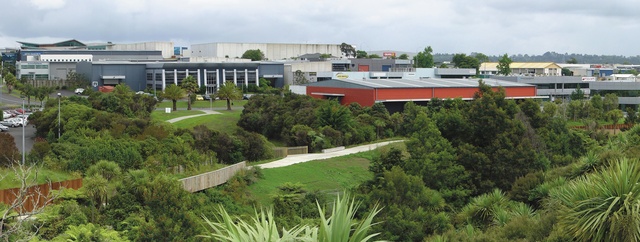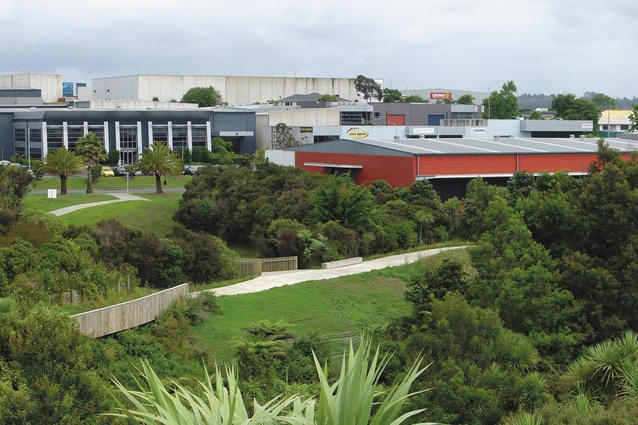Te Ara Alexandra stream cycle path
Stage one of transportation network for the North Shore of Auckland – connecting parks, reserves and backyards.
Cycling as a sport and pastime for New Zealanders has continued to grow in popularity – the idea to build a New Zealand-wide network of cycleways is an acknowledgement of this, yet a series of terrible cycling accidents has made imperative the search for ways to make cycling safer.
Local government responded to the challenge in a number of ways. The North Shore City Council developed a strategic cycle plan back in 2003, reviewed in 2008, to reflect new ideas for the implementation of cycle paths. Three kinds of cycle networks were consequently developed: a strategic cycle network, a local cycle network and a green cycle network. The most important network was deemed to be the strategic network – a system of direct routes through the city, connecting the critical destinations on the North Shore. The second order network was the local system, aimed at connecting cyclists with local destinations. The last network, the green network, recognised the existence of the sometimes forgotten, and in many cases degraded, network of suburban streams on the North Shore. This network revealed a curious pattern of uses; the stream networks connected parks, reserves, and back yards. More importantly, the council owned land along these streams, meaning property purchase wasn’t required. Existing footpath networks could be used to provide a route for new cycleways. This insight opened up other possibilities; the construction of the cycleways could be coordinated with the various stormwater infrastructure projects that the council was planning, such as the restoration of streams, wetland enhancement and the upgrading of existing stormwater ponds adjacent to streams. The cycleway programme could also be coordinated with the parks department, helping to increase the public use of council owned property.

A good case study of the initiative is stage one of the Alexandra Stream cycle path. The design was initiated in December 2008 with construction completed in early 2011. The Alexandra Stream is medium in size, running through a number of parks and reserves for about 3.5 km, roughly south-to-north from Unsworth Heights to the Albany Creek. The first stage of the cycle path runs from Rook Place to Rosedale Park North.
Two studies of the stream had been carried out: an environmental study by UIT and a stormwater management study by Morphum Environmental. In 2008, the council commissioned Daryl Lim to develop the cycle path route. Our landscape firm was commissioned to provide an urban design and CPTED review of the proposed plan. Our recommendations included developing the track as a more multi-functional space to attract more users from the wider community, for instance, by constructing sitting areas at critical path junctions and increasing passive community surveillance of important areas. Lighting and artworks were recommended for an existing underpass, to give added security. Information boards were recommended to inform passersby of the important ecological functions of the stream.
These measures made the path available to a broader section of the community and also made it viable to users for a longer part of the day. Overseas studies show that these kinds of measures help make the cyclist and pedestrian feel safer and less vulnerable.
A number of detailed studies focussing on the specific environmental conditions that the track passed through were undertaken, which revealed a complex landscape with overland flow paths, ephemeral streams, fragments of native bush, and a steep topography. This led to the development of a range of construction techniques that responded to specific site situations.
In some cases, construction techniques not traditionally used in park construction were adapted; steel sheet piling, for instance, usually applied in the construction of large-scale infrastructure projects, was used to retain sections of the path. The thin section of the retaining material and the installation technique meant native bush fragments, which would have been destroyed by using conventional retaining walls, were preserved. Permeable concrete was used for some sections of the path to reduce stormwater run off and improve water quality, and recycled crushed construction concrete was used in drainage trenches. Green Terramesh walls were used to retain the lower sections of paths to ensure the integration of the native plant restoration with the retaining wall structures. Construction materials were chosen to require negligible maintenance: tanalised timber bridges, galvanised steel light poles, and poured concrete seats with a simple board-faced finish were some of the material choices.
The construction of stage one has been a success story. It’s a new amenity for Aucklanders – and not just for cyclists and pedestrians, but for skaters, BMX riders, commuters and gym bunnies. Importantly, the cycleway opens up alternative transport options for the car-dominated North Shore suburbs. From the sports field, café, gym, office and suburban house, a new ecologically friendly and safe network now joins the community – a new linear park for Auckland.












